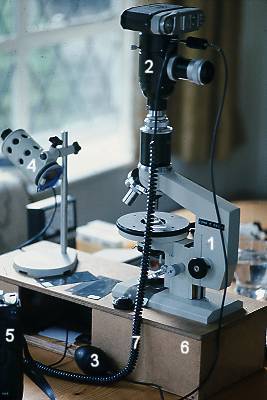
|
Flash Photomicrography.
Electronic Flash as a Light Source for Photography through the Microscope. |
Page 2 of 7 |

|
Flash Photomicrography.
Electronic Flash as a Light Source for Photography through the Microscope. |
Page 2 of 7 |
 The picture shows a photomicrographic setup using a Russian Biolam student microscope stand (1) combined with a Zeiss photomicrographic camera (2), actuated by the bulb (3) of a pneumatic remote shutter release. The Russian microscope lamp (4) is set up for Köhler illumination and serves as the modelling light of the flash setup.
The picture shows a photomicrographic setup using a Russian Biolam student microscope stand (1) combined with a Zeiss photomicrographic camera (2), actuated by the bulb (3) of a pneumatic remote shutter release. The Russian microscope lamp (4) is set up for Köhler illumination and serves as the modelling light of the flash setup.
The flash unit is a Metz 202. Its battery pack (5) powers a hammer-head flash module, which is located in the box (6) supporting the microscope, and is arranged so the light from the flashtube and its reflector is directed upwards through the hole in the microscope base beneath the mirror. A normal synch. cable (7) connects the camera to the flash head. The microscope mirror is inconel semi-silvered, replacing the normal mirror, and is the means by which the flash and modelling lights are combined. Light absorption in the metal film of this mirror (below, 8) and the degree of diffusion neccessary to reduce unevenness in the flash illumination caused by flash reflector artefacts are two important factors which reduce the the intensity of flash light which can be delivered by this method, and restrict its use to the lower powers of the microscope. Any further attenuation of the flash illumination is achieved by laying neutral density gels (9) over the hole in the microscope base which allows light from the flash through to the mirror and condenser (10). Placing the gel in this position allows the flash intensity to be adjusted without affecting the intensity of the modelling light.  Even if flash attenuation were not a problem, the other factor which makes the method unsuitable to the higher power objectives is the uncertain optical relationship between the light delivered by the flash and that delivered by the modelling light.
Even if flash attenuation were not a problem, the other factor which makes the method unsuitable to the higher power objectives is the uncertain optical relationship between the light delivered by the flash and that delivered by the modelling light.
The microscope lamp used for the modelling source may well be set up in a proper Köhler configuration, but the flash reflector with its associated diffusers is definitely not. This means that there is no guarantee that the lighting effects established using the modelling light will be replicated by the flash exposure, making the shooting of pictures a rather hit-and-miss affair. The problem could be reduced by ensuring equal distances of flash reflector and modelling lamp from the microscope, but in this particular case, neither the size constraints on the box housing the flash, nor the optical properties of the modelling lamp made this an easy option. Click to see a picture taken using the above setup. And another. The best way of avoiding the difficulties of the above system is to go straight to the ideal solution, which involves combining the flash and modelling sources by optical means using a specially designed dual-source microscope lamp. Such a photomicrographic lamp was marketed by Zeiss in the 1960s, and a variant of that design is discussed in the following pages. |